WHAT IS THE IMPORTANCE OF PACKAGING AND HOW CAN IT INCREASE SALES?
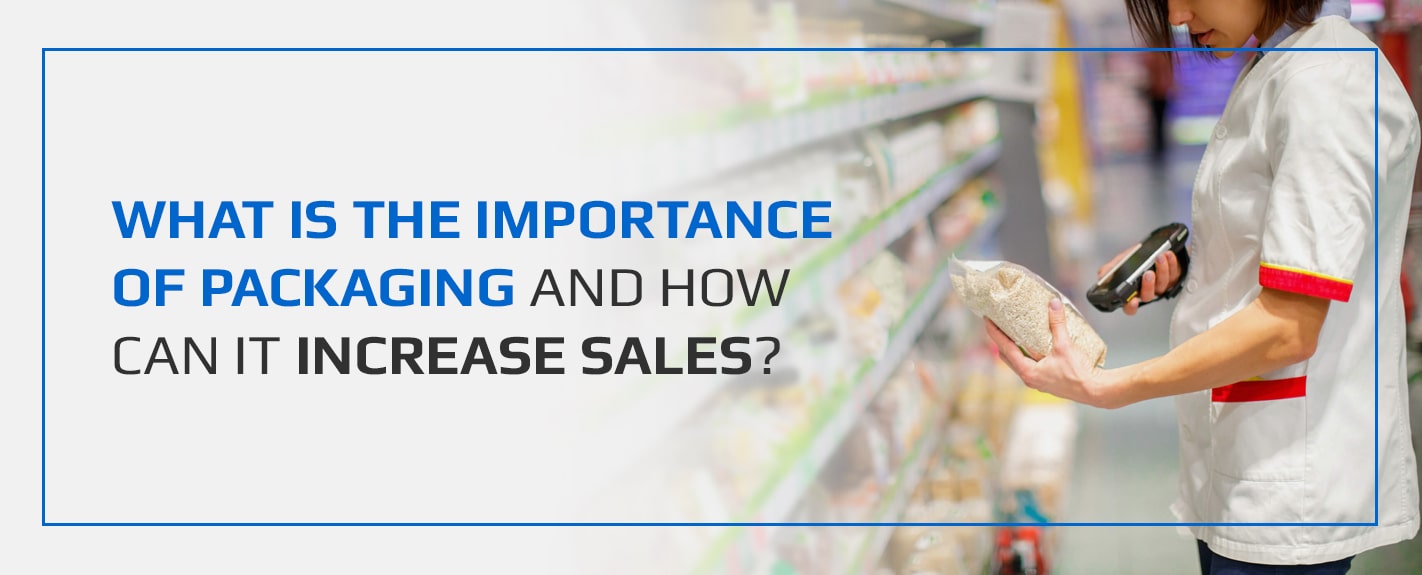
Posted: August 27th, 2019 Author: Jim Higgs
TABLE OF CONTENTS
What Is the Importance of Packaging?
How Packaging Can Increase Sales
Impact of Product Packaging on Consumer Buying Behavior
Choosing the Right Product Packaging
Types of Product Packaging
Make Your Packaging Pop With Custom Designs and Colors
Packaging your products is usually necessary for transporting them and getting them to market, but it’s also a huge opportunity to increase sales. According to a recent survey, 72 percent of consumers say that packaging design influences their purchasing decisions. If you’re not putting enough focus on your packaging, you’re missing out on potential sales and opportunities to promote your brand. Let’s explore how product packaging can affect sales and why packaging is necessary.
WHAT IS THE IMPORTANCE OF PACKAGING?
Does product packaging matter? Absolutely. Packaging plays numerous essential roles for today’s companies and their customers, and it has various practical roles to play as well as functions related to marketing, sales and brand awareness.
One of the important functional roles that packaging plays is protecting products during transportation and right up to the moment the customer opens the package. If the product is damaged when the customer receives it, their perception of your company will also be damaged, and you’ll likely have to either replace the product or return their money. The packaging should also be easy to open, and the packaging design should make it easy to remove the product from the package, as this makes for a better customer experience.
Another functional role that packaging plays is that of helping consumers to identify products. The packaging should provide enough information, through text, images and other forms of communication, that the consumer can quickly determine what is in the package. Differences in packaging, such as in color, can also be useful for denoting different models of a product within one brand.
Packaging that includes brand elements, such as logos, brand colors and brand fonts, can also help customers identify the company that makes a product. It can also help new customers get familiar with your brand and improve brand awareness. Packaging is a huge brand awareness opportunity and should also match the brand personality of the company selling the product.
Your packaging also has an essential role to play in boosting sales, which we’ll discuss in the next section.
HOW PACKAGING CAN INCREASE SALES
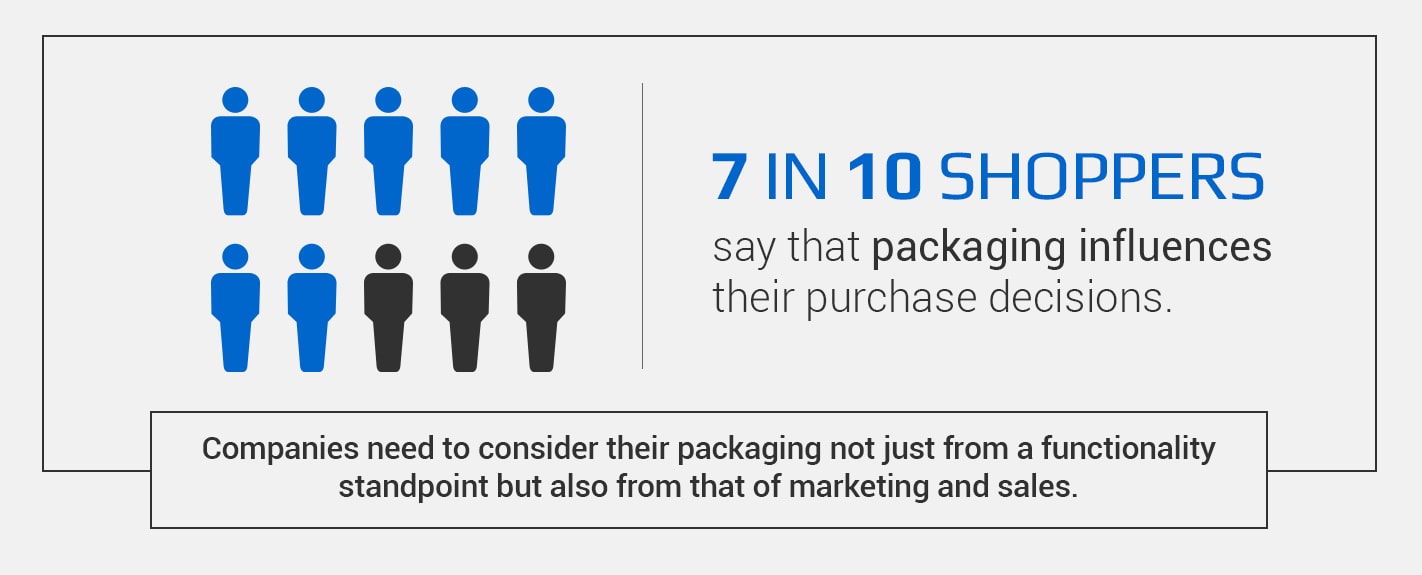
Since more than seven in 10 shoppers say that packaging influences their purchase decisions, companies need to consider their packaging not just from a functionality standpoint but also from that of marketing and sales. How does packaging impact sales?
When consumers are faced with an array of product choices either in the store or online, a primary factor in their decision-making is product packaging. When choosing which product to pull off the shelf and consider purchasing, consumers have little information to go off of besides the packaging unless they did prior research. Many shoppers will choose a product with packaging that catches their eye. In fact, a majority of shoppers have tried a product because its packaging caught their attention on the store shelf, highlighting the importance of using your package design to help your product stand out from the competition.
After consumers pull an item off the shelf, they will often read the label to ensure it’s the right product for them. In this way, the information you put on your packaging plays a critical role in customers’ decision-making processes. It’s essential that you provide sufficient information and do so in an easily readable and understandable way.
Your packaging is often the first impression that someone gets of your company, and it’s crucial you make that first impression a good one. If your packaging is high-quality, customers are more likely to associate your brand and your products with quality. It’s especially important that your packaging adequately protects your products. If it does not, it can appear to customers that you do not care enough about your products and your customers.
As mentioned earlier, packaging is an excellent tool for increasing brand awareness. You can prominently display your logo and other brand elements on your packaging, and the package itself can also be an element of your brand. When customers see your packaging in the store, they’ll become aware of your brand and will be more likely to think of your company the next time they need a product you provide.
Packaging can even be an effective online marketing tool. Customers may share images of aesthetically pleasing or unique packaging on social media, which helps to boost awareness of your brand and serves as something of a recommendation from the customer posting the image. In a recent survey, 39 percent of online shoppers said they’d shared a photo or video of a new product, and 60 percent said they’d be more likely to do so if it arrived in a gift-like box instead of a traditional brown box. Unboxing videos, in which someone opens a product package, are also popular. Among the survey respondents, 35 percent said they had watched an unboxing video, and 55 percent of those respondents said that the video convinced them to purchase the product.
Updating packaging or offering limited-edition or seasonal packaging can also encourage existing customers to make another purchase, giving a boost to sales during holidays or typically slow times of the year.
IMPACT OF PRODUCT PACKAGING ON CONSUMER BUYING BEHAVIOR
Part of the reason that packaging can have such an effect on sales is that it influences people’s perception of products. One study from researchers at the University of Twente in the Netherlands had participants view images of packaged dairy products and place them in categories. They found that packaging, especially packaging color, played a significant role in how participants perceived the products. Another study, published in Frontiers in Psychology, looked at how the packaging of snack products influenced how children perceived the products’ taste and found evidence that the marketing cues on the packaging had a substantial influence.
Product packaging also has an impact on shoppers’ emotions, a study published in the journal Psychology & Marketing found. The researchers used an fMRI machine to measure brain activity while participants looked at various types of packaging. They found that when participants saw attractive packaging, they had more intense brain activity, including in areas associated with rewards. Unattractive packaging, on the other hand, caused activity in parts of the brain associated with negative emotions. These emotions likely influence purchase decisions.
Color is one aspect of packaging that has been the subject of much research. Studies have shown that the color red is stimulating and increases our heart rates. It may also increase appetite, which is why so many food and beverage companies use it in their logos and packaging. The shape of packaging also has a psychological effect on us. When beer brand Hasseröder, which targets a male audience, changed the shape of its bottle to make it more angular, a trait associated with masculinity, sales increased.
CHOOSING THE RIGHT PRODUCT PACKAGING
So, how do you choose product packaging that will help you boost sales? Consider the following.
- Your audience: One of the key factors to keep in mind is your audience. You need to understand their preferences, interests and what they expect from your product. Researching by surveying customers and digging into your customer data can help improve your knowledge in this area. For instance, your customers might value packaging that’s easy to open or prefer soft, pastel colors.
- Your brand: Your packaging should also fit in with your brand’s personality, as this will help customers to identify your products and help you create a cohesive brand identity. If your brand is sleek and modern, for example, a stand-up pouch with metallic ink and a minimalistic design may work well.
- The product: Of course, your packaging will also need to make sense for your product. Laminated tubes are often used for pastes, for example, while retort pouches are used for ready-to-eat meals. Your packaging should help shoppers to quickly identify what type of product you’re selling.
- What you need to protect your product from: You should also consider what you need to protect your product from so that it’s still in optimal condition when the end user receives it. Many food products, for example, require a material that keeps moisture and oxygen out, so using a foil, metalized or clear barrier is crucial. Other types of packaging materials are designed to protect electronic products from electrostatic discharge.
- Standards you need to comply with: Another factor to consider is any package-related standards, rules and regulations you need to comply with. If you’re selling food products in the United States, you need to adhere to U.S. Food and Drug Administration (FDA) regulations as well as any state-specific laws. If you’re providing products to the military, you need to ensure you follow military specifications.
- Your budget: It’s crucial to balance all of the other factors you’re considering with your budget. You’ll need to keep in mind the costs of materials, designer services, package production and product distribution and find partners to work with that can provide the products and services you need at prices that are within your budget range.
TYPES OF PRODUCT PACKAGING
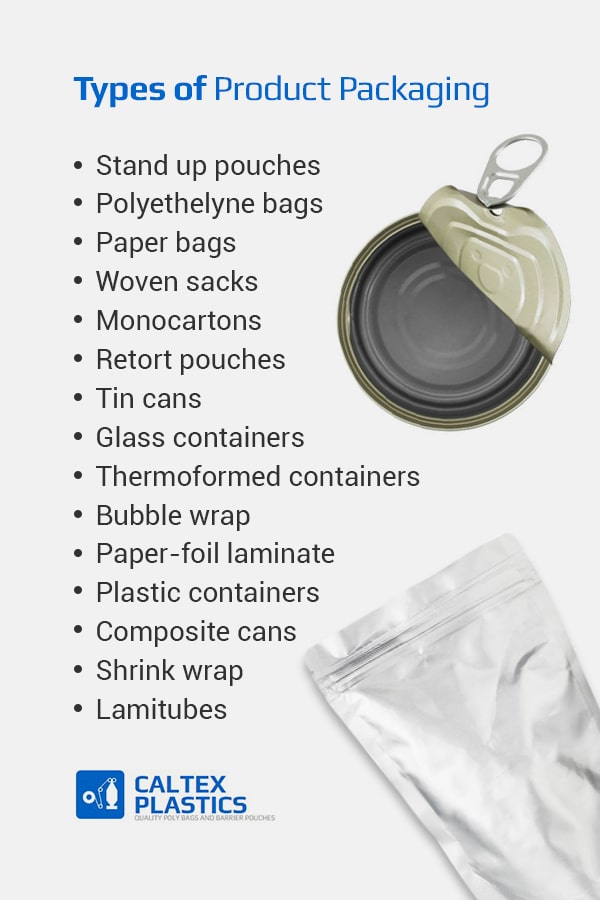
There is a huge variety in the types of packaging that today’s companies can use for their products. Here are some of the most common ones:
- Stand up pouches are made of polymer sheets or metalized plastics and are often laminated. They are similar to bags but can stand up and are often used for food products.
- Polyethelyne bags are plastic bags that are used for a variety of products, including both liquids and solid products.
- Paper bags are lightweight and offer the advantage of being recyclable and biodegradable.
- Woven sacks are used for heavy-duty packaging purposes and are often used for agricultural products, food packaging and geotechnical engineering supplies such as cement and sand.
- Monocartons are boxes made from paperboard and are often used for food products.
- Retort pouches are made of metalized plastics and are used for ready-to-eat meals.
- Tin cans are used for food, drinks and other liquid products such as oils. They may be laminated on the inside.
- Glass containers are one of the oldest kinds of packaging used today. They’re used for a variety of food and drink products.
- Bubble wrap envelopes or sheets, which contain air pockets, are used to protect products from damage.
- Plastic containers are used for a wide variety of products and are one of the most common types of packaging used today.
- Composite cans are made from multiple layers of paper, paper board, aluminum foil and plastic laminates.
- Paper-foil laminate is packaging made from paper laminated with aluminum foil, which makes for a durable and low-cost packaging material.
- Shrink wrap is a polymer plastic sheet used to protect retail packaging, prevent tampering and label products.
- Lamitubes are used to package pastes, are made with multiple layers of plastics and may be metalized.
- Thermoformed containers are made from plastics that have been heated to enable easy molding. Common examples include egg crates, meat trays and blister packaging.
MAKE YOUR PACKAGING POP WITH CUSTOM DESIGNS AND COLORS
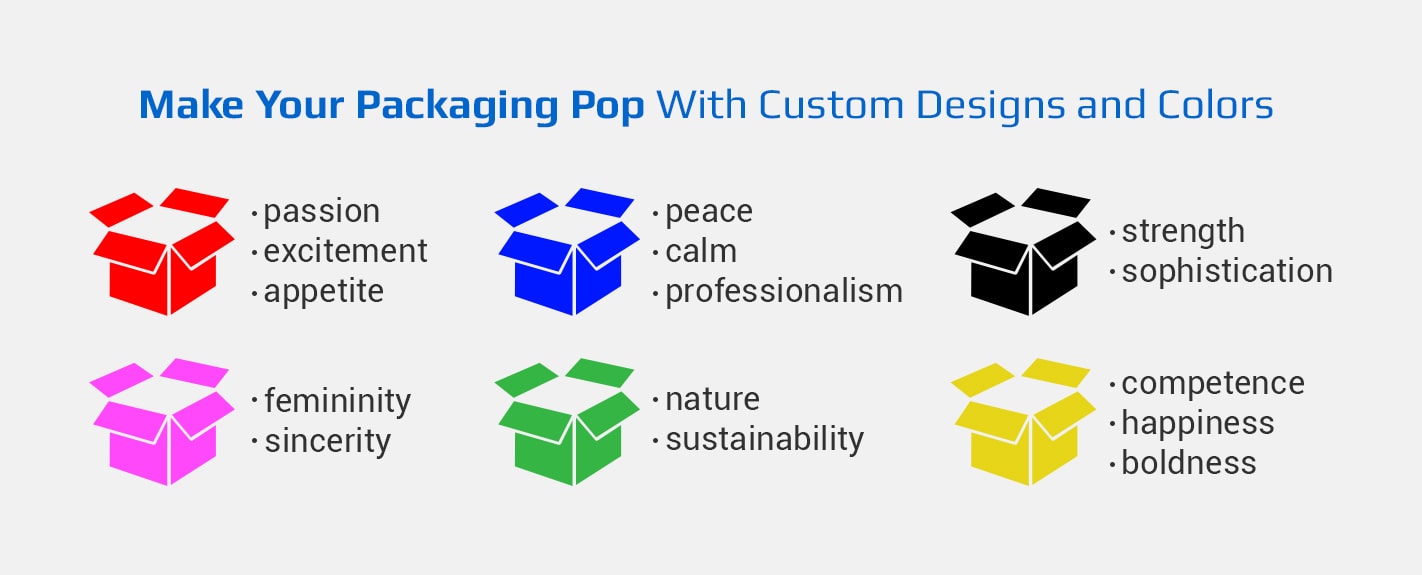
There are numerous options when it comes to packaging, and you need to make sure you consider your audience, brand, product and the functionality you need to help your packaging stand out and increase sales. One way to make your packaging distinct from the competition is with custom designs and colors. Custom packaging can increase sales, and a uniquely shaped container or eye-catching color is an excellent way to ensure customers notice your product among the sea of competing products on the store shelves.
Consider a shape that matches your brand and will appeal to your customers. As mentioned earlier, shapes with more edges and angles are associated with masculinity, while ones with more rounded edges and curves are associated with femininity. A simple design gives your product a minimalistic feel and compliments a sleek, modern, sophisticated brand. Meanwhile, a distinctive, eye-catching shape works well for a fun, adventurous brand. Try unique packaging types such as stand up pouches to make your product stand out and increase sales. Its uniqueness is one of the secrets of how stand up packaging can increase sales.
Color can also help to capture customers’ attention and create packaging that matches your brand and elicits a positive response from customers. Be sure that you study the reactions typically associated with colors and keep in mind that these associations can vary from region to region. Some common color associations include:
- Red: passion, excitement, appetite
- Blue: peace, calm, professionalism
- Black: strength, sophistication
- Pink: femininity, sincerity
- Green: nature, sustainability
- Yellow: competence, happiness, boldness
Working with packaging designers and manufacturers that can provide custom designs and colors is crucial to helping your products stand out. Finding the right combination of elements may take some time, but researching the feelings and ideas associated with various shapes and colors can help you choose packaging that will resonate with your customers.
CALTEX PLASTICS, YOUR CUSTOM PACKAGING MANUFACTURER
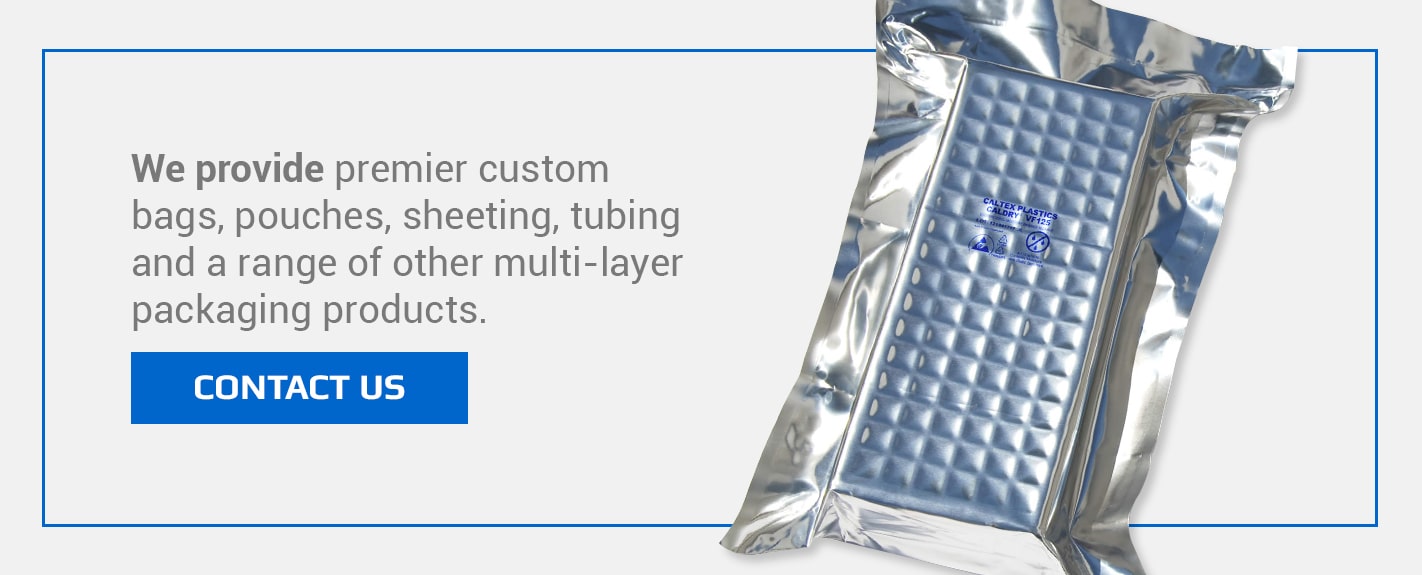
At Caltex Plastics Inc., we’ve been helping our customers protect their products with high-quality packaging materials since 1984. We’re committed to cost-effective pricing and quick delivery of our packaging solutions, which is why we run our operations 24 hours a day and seven days a week.
We provide premier custom bags, pouches, sheeting, tubing and a range of other multi-layer packaging products. Our products meet the necessary testing requirements and standards, whether you need to comply with MIL-SPEC, FDA regulations or AIB certification.
To learn more about how we can help you protect your products, wow your customers and boost your sales, contact us today.